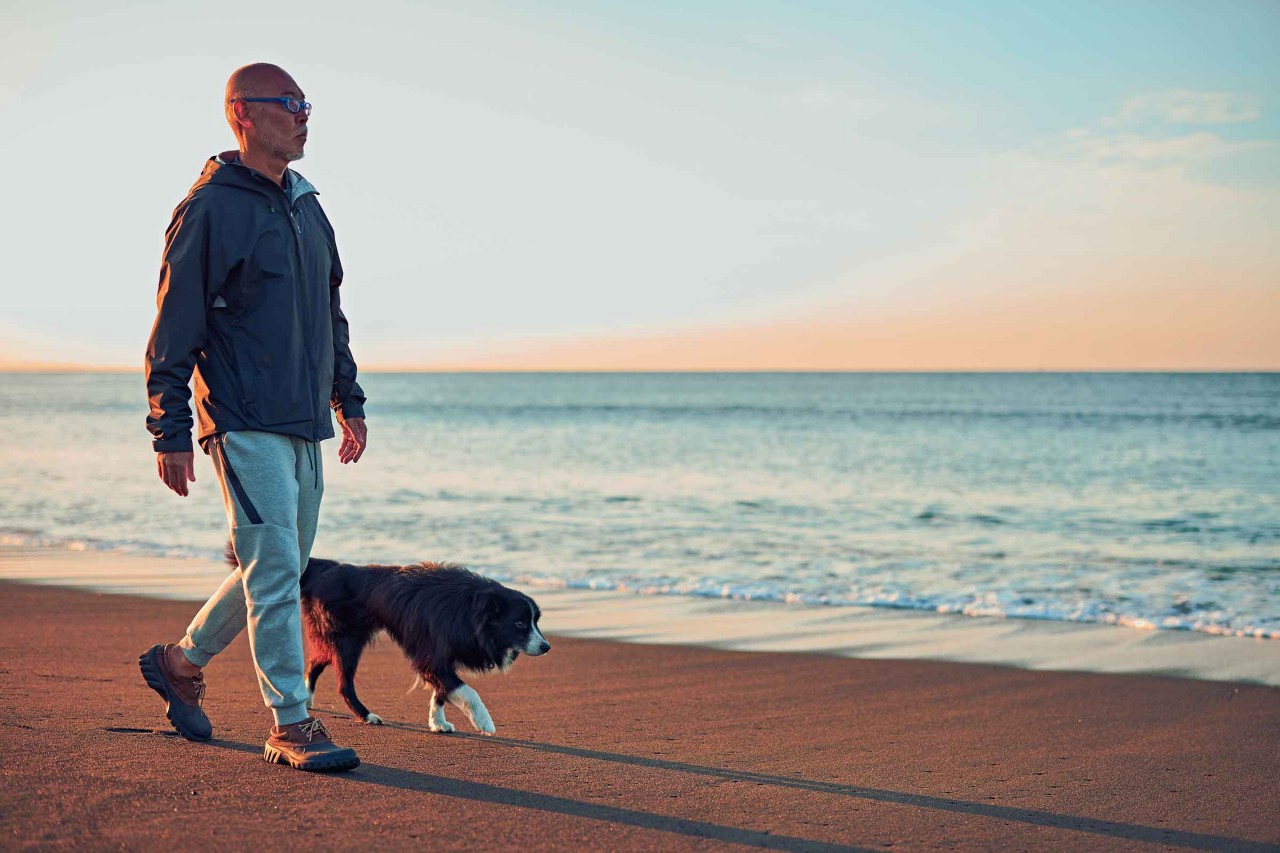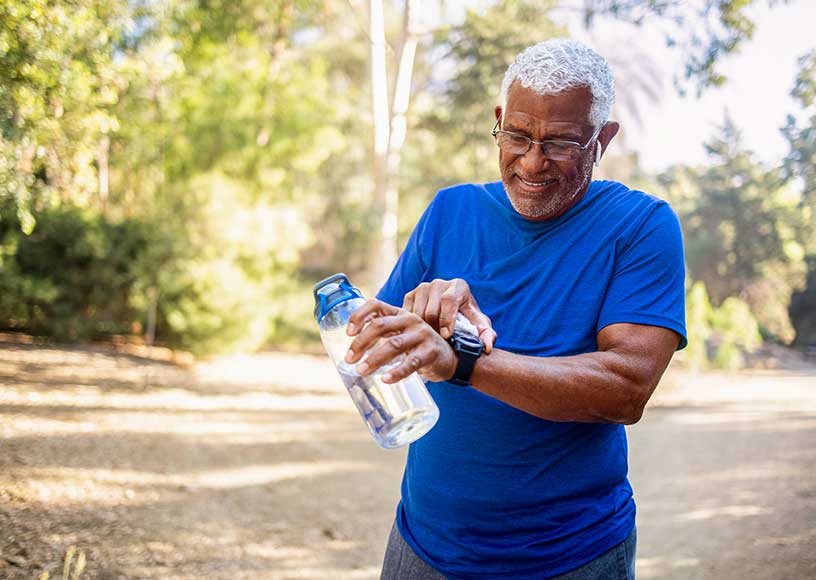Are you as active as you think you are?

If you want to stay active and feel good as you age, the Centers for Disease Control and Prevention (CDC) recommends that people age 60 and older get in 150 minutes (2½ hours) of moderate-intensity activity a week. And while that sounds like a lot, it just means doing anything that gets your heart pumping for at least 10 minutes at a time, working up to 20 to 30 minutes most days — from dancing to walking to golfing.
Luckily, it seems older adults are taking note, at least according to the University of Michigan’s 2021 National Poll on Healthy Aging. About 28% of adults 50 to 80 are getting the recommended amount of heart-pumping exercise for 30 minutes most days, and about 51% are achieving that goal at least once a week. So that’s good news.
How movement may help protect your health
Why is it so crucial to keep aiming for that 150-minute goal? “As we grow older, we lose muscle mass. Once you lose that muscle strength, it’s harder to regain it as you become older,” says Araz Melkonian, M.D., associate medical director at Vituity Family Medicine Center in Glendale, California. Your best strategy is to prevent it in the first place. When your muscles get weaker, your chances of staying independent decrease.
Other important reasons to keep moving: “If we need to be hospitalized as older adults, it could protect us from hospital-acquired weakness,” notes Allyson R. Armstrong, DPT. She’s a certified specialist in geriatric physical therapy at the Veteran Health Administration in Salt Lake City. Getting regular exercise may also help you reduce your chances of getting many diseases, including heart disease, stroke and even some cancers, she says.
And exercise may also help you manage conditions you already have, Dr. Melkonian explains. For instance, staying fit can keep your weight in check, which helps control diabetes and high blood pressure. And if you have COPD or asthma, working out may help ease symptoms (including shortness of breath) by improving the way your body uses oxygen.
Learn how active you really are
Your perception of how active you are might not match reality. “A lot of older adults who are functioning well will say, ‘I’m fine: I have friends who can’t do anything, and I can do all these things,’” says Armstrong. To get an accurate picture, your primary care provider (PCP) may ask you to describe your day to discover how active you are and how you can improve your activity level.
Answer the following questions to get a better sense of your overall activity level. Along the way, you’ll find plenty of ways to sneak in even more heart- and body-strengthening exercises into your day.
Don’t forget to review your answers with your primary care provider (PCP) at your next checkup.
1) How many days this week have you exercised for at least 20 minutes?
Dr. Melkonian says most providers will ask you a variation of this question: How many times a week are you walking and for how long? “We usually follow what the American Heart Association defines as exercise,” he says. That means walking at a faster-than-regular pace for 20 to 30 minutes on most days.
But if that’s not you, don’t panic. There are other ways to stay active that don’t involve swimming, walking or biking.
Many older adults don’t have a regular exercise routine but are very active, says Dr. Melkonian. For instance, they take care of their young relatives. “Running after your grandkids is enormous exercise,” Dr. Melkonian notes. So are household chores such as vacuuming and yard work, according to the American Academy of Family Physicians (AAFP).
Try sneaking in
A stroll around the store
When it’s too hot or cold to exercise outside, go to the mall or a big-box store during non-crowded times of the day. “Spending time in the mall, just walking from one store to another, counts as exercise,” notes Dr. Melkonian.
Another activity with a buddy
People do better if they have someone to hold them accountable, Armstrong explains. For instance, if you’re already doing a 10-minute walk in the morning, add another 10-minute walk in the afternoon with a friend or your partner.
2) When you go to the grocery store, do you park far away and push your own cart?
Ask yourself this question to get an idea of how far you’re walking once you get there. If you’re parking in the closest spot to the door and riding in a motorized shopping cart, you aren’t moving as much as the person who parks near the back of the lot and pushes the cart from aisle to aisle, notes Armstrong. The good news: Carrying grocery bags into the house is a muscle-strengthening exercise, according to the AAFP.
Try sneaking in
Balance exercises
Most people, no matter how fit they are, are surprised at the results when Armstrong tests their balance. “A patient may be really good at walking but still report that they’re falling a lot,” says Armstrong. “Balance, just like any muscle, can be strengthened, and you can help improve it with practice.”
The next time you’re waiting in line at the grocery store, try standing on 1 leg and see how long you can do that without holding on to the cart. Or stand with 1 foot in front of the other as if you were on a tightrope without using your arms to help you stay steady.
3) How many times a day do you get out of your chair to walk around your home?
Not everyone can meet the recommended exercise guidelines. But even if you have a chronic condition or need a walker to get around, the Centers for Disease Control and Prevention (CDC) recommends staying as active as you can. So, if you’re just going from your chair to the bathroom a few times a day, you still can find ways to up the number of steps you walk. After all, the goal is to move more to the best of your ability.
But you need to stay safe, which is why Dr. Melkonian checks to see how fast his patients can rise from a sitting position and their walking style: “Are they shuffling or not? Or does their trunk shake when they walk?” he asks.
These are all clues to assess the risk of falls. If you tend to shuffle or find it hard to get out of your chair, ask your PCP for ways to strengthen your muscles.
Try sneaking in
Another round trip
Each time you get up from your chair to go someplace such as the bathroom, add another round trip, recommends Armstrong. “That way, you would almost double the amount that you’re walking just by walking it twice every time you go,” she explains.
A chair exercise
Try this during a commercial break as you watch TV: Rise from your seat and then sit back down 10 times. “Just stand up, sit down, stand up, sit down — 10 times in a row. If you can do that, start trying to do it as fast as you can. That way, you’re working on some leg strength,” says Armstrong. Do it quickly enough and it’ll get your heart rate up. Bonus points if you don’t use your arms to help.
4) How many times a day do you go up and down the stairs in your home?
When patients tell Armstrong that they’re navigating the stairs many times a day, that gives her a good idea about their heart and lung capacity as well as how strong their legs are.
But stairs can also raise your risk of accidents. Each year, roughly 1 million people of all ages are treated in emergency rooms for stair-related injuries, according to a 2018 study in The American Journal of Emergency Medicine. Kids and older adults are most likely to suffer more serious harm, with people over age 60 being treated for fractured and broken bones. That’s why Armstrong always screens her stair-climbing patients for fall risks and balance. Armstrong says that patients without stairs in their home “can practice standing on one leg at a time, initially with their arms supporting them on a counter, and progressing to no hands and increasing time.”
Try sneaking in
More stair-climbing
Since stairs are a great way to strengthen your legs and boost your body’s ability to use oxygen, Armstrong recommends that her patients increase the number of times they go up and down the stairs — after she’s made sure they’ll be safe with more trips up and down.
Calf raises
Stand at the foot of the stairs, and raise and lower your heels 12 times, holding on to the end of the banister if you need to. Calf raises may be good for keeping your ankles stable, which in turn makes walking (and climbing) easier. They’re also good for boosting balance.
5) How long are you out in the yard?
Raking leaves, pushing the lawn mower, and digging all meet the CDC’s guidelines for aerobic and muscle-strengthening activities. But gardening involves many other tasks, from weeding, to watering and planting, to pruning.
And since you’re constantly using your hands, gardening also strengthens those muscles as well as the ones in your upper body, Armstrong says.
If you don’t have your own backyard to tend, consider joining a community garden. That way, you’ll also get the benefits of mingling with other folks, which may be another excellent way to protect your physical and emotional health.
Try sneaking in
Walks in the neighborhood
“Try walking to your mailbox more times throughout the day,” Armstrong says. “Walks in the neighborhood can be good. Make sure to scan your environment for uneven surfaces. If you master this, go to a grassy or gravelly area. Don’t have access to a safe outside space? Try going from a kneeling position at a chair or couch to standing to mimic getting on and off the ground if you were gardening.”


